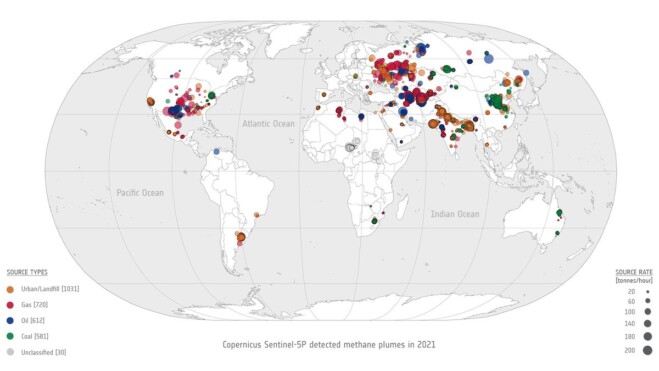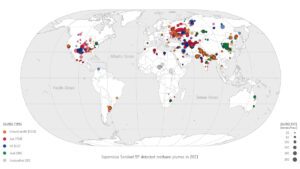

A global overview shows the location and magnitude of all 2,974 methane super-emitter plumes detected in 2021 using the Copernicus Sentinel-5P Tropomi instrument onboard the Copernicus Sentinel-5P satellite. Researchers from SRON Netherlands Institute for Space Research announced a new algorithm that automatically discovers methane super-emitter plumes in Sentinel-5P data using machine learning. (Credit: ESA/SRON)
Methane is a powerful greenhouse gas and is the second-largest contributor to climate warming after carbon dioxide.
A tonne of methane, despite its shorter lifespan of about 10 years in the atmosphere, can retain an astounding 30 times more heat than a tonne of carbon dioxide over the course of a century. This means that when it comes to warming our planet, methane is a potent player.
But here’s the good news: because methane doesn’t stick around as long as carbon dioxide, it provides us with an opportunity to take relatively swift climate action. If we reduce methane emissions, we can actually see a tangible reduction in global methane levels within just a decade. This, in turn, helps mitigate the enhanced greenhouse effect.
Now, let’s talk about “super-emitters.” While methane emitters refer to any source of methane ranging from natural processes like wetlands or human activities such as agriculture, methane super-emitters release a disproportionately large amount of methane compared to other emitters.
These are typically found amongst industrial facilities, such as oil and gas operations, coal mines or even landfills that have equipment or infrastructure issues leading to significant methane leaks.
These super-emitters are the low-hanging fruits in our quest to cut emissions. Fixing these super-emitters doesn’t require complex or expensive solutions. In many cases, relatively simple repairs can result in significant climate gains.
However, there’s a challenge: we first need to identify these super-emitters. That way, we can target our efforts effectively and start making a difference in the fight against climate change.
Click here to learn more.
